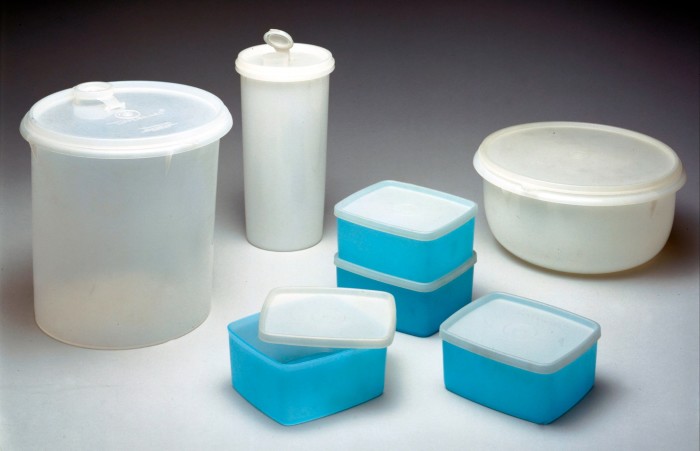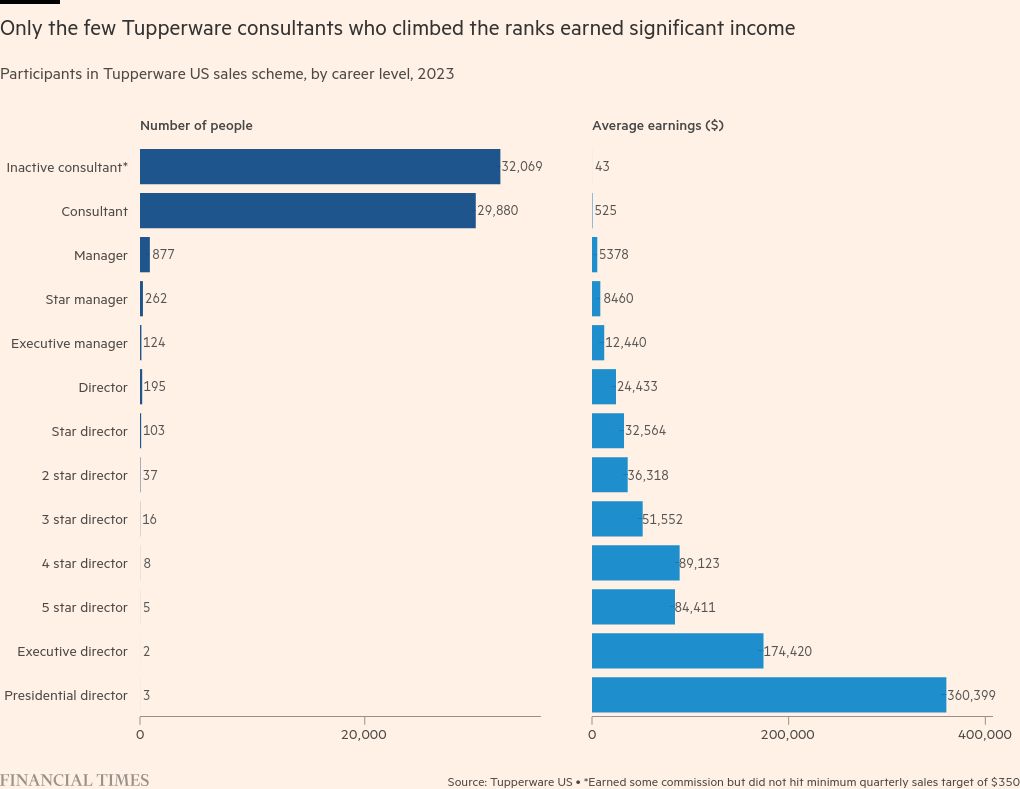
The name Tupperware conjures images of plastic food boxes and parties in the comfortable suburban homes where they are sold. After the company sought bankruptcy protection this week, the future of both is in question.
The clever containers with resealable lids became a mainstay of American kitchens after Earl Tupper introduced them in 1946. Sales boomed after he hired Brownie Wise, a single mother who pioneered the Tupperware party, where hosts invited friends and family to show off the wares and take orders.
The model made Tupperware a pillar of the direct-sales industry, with armies of contractors earning commissions on sales in addition to bonuses for signing up new recruits. At Tupperware, most of the salespeople are women.
While the numbers have been dwindling, Tupperware still has a salesforce of more than 465,000 worldwide, the company said in a bankruptcy court filing this week.
“For nearly half a million people, a significant portion of their income if not their livelihoods are dependent on this business,” Spencer Winters, a lawyer for the company, told the bankruptcy judge at its first court hearing on Thursday.

A combination of factors dragged the company down: a backlash against plastic, a patchy global distribution network and the increasing anachronism of house party sales in the age of online shopping. Competitors from Rubbermaid to flimsy generics also encroached on the market.
Yet the parties remain a mainstay of the business. “A representative from Tupperware usually leads the event, showcasing various products, demonstrating their uses and sharing tips on food storage and meal prep,” Jeri Fortune, a Tupperware consultant who lives in Ohio, said in an email.
Tupper sold his company in 1958. After operating as a subsidiary of a number of different businesses, including the food company Kraft, Tupperware was spun off and listed in 1996. Revenues and net profits peaked in 2013 at $2.7bn and $270mn respectively, while its share price hit a high of nearly $100.
The early 2010s were boom years for the likes of Jennifer Suchan of New York’s Long Island, who became Tupperware’s top seller with annual sales peaking at $365,000 while performing in drag. “I was known as the queen of Tupperware,” Suchan said in an interview.

Then in 2015, Suchan transitioned from male to female. “People thought it would be funnier when a man is dressed as a woman rather than a transgender woman dressing in character selling Tupperware, so my business just slowly declined,” said Suchan.
But Suchan still sells part-time, saying: “There’s certainly a lot more competition out there. But Tupperware to me is the Cadillac of food storage.”
Tupperware’s business received a boost when people cooked at home more during the pandemic, though the parties had to go online. The bump did not last. By 2022 — the latest full year the company has reported — revenues had fallen to $1.3bn. In its bankruptcy petition, Tupperware declared $680mn in assets and $1.2bn in debts. Its shares are trading at about 50 cents.
Demand for plastic containers has not disappeared. In the US, retail sales of food storage products totalled $1.8bn in the past year, according to Circana, a market information company, about 18 per cent higher than before the pandemic.
But consumers now buy about three-quarters of their homewares in shops and 20 per cent online, said Tupperware chief restructuring officer Brian Fox in a bankruptcy filing, adding that the company “began finding itself ‘late to the party’ when it came to modern consumers”.
Some Tupperware is now sold by big retailers including Target, Macy’s and Amazon, as well as in independent stores in markets such as China. The majority of Tupperware’s sales come from outside North America.

Moving beyond direct sales has been tricky. Tupperware is a frequently searched term on Amazon, with approximately 500,000 searches a month, but one of the company’s challenges is that a search for its name brings up results for other brands, Fox said.
Signing up new salespeople remains critical to Tupperware’s market reach. An undated company “business binder” for new consultants lays out rhetorical tactics for persuading new candidates. “The more people you recruit, and the more they sell, the more they make AND the more you make!” it says.
Income data on Tupperware’s website reveals that earnings are scanty for the vast majority of salespeople. In 2023, more than half of its salesforce was considered “inactive”, while the biggest cohort of active salespeople earned an average of $525 for the year.
Tupperware salespeople contacted by the Financial Times were optimistic that the company would continue after working out its debts in the bankruptcy process.
“Just because they’re filing for bankruptcy doesn’t mean they’re going out of business. Any publicity is good publicity. I’m sure my sales will pop up this month by at least $1,000 because of this,” said one saleswoman, a 25-year Tupperware veteran from Nebraska.

Tupperware has tried to sell itself for years and on several occasions received formal bids. In July, it even prepared documents for another company to take it over through a streamlined bankruptcy sale process, but that fell apart when its biggest lenders pushed back.
Around the same time, a big slice of the company’s debt changed hands from a group of banks to hedge funds and other investors, including Alden Global Capital. They objected to Tupperware selling itself through bankruptcy to another business and instead wanted to foreclose on a number of the company’s assets out of court — including the Tupperware brand, according to court filings.
However, the board of directors decided that too many vendors, tax authorities and other parties were involved for such a significant transfer of assets — especially those of a public company — to happen behind closed doors.
“The board concluded that the transfer of such an iconic asset should happen in broad daylight,” Winters said during the bankruptcy hearing on Thursday. Now the company is looking to sell itself at near-record speed, in a 30-day bidding process.
The creditors have a different idea. They have petitioned the court to block Tupperware’s use of $7.4mn in cash on hand to cover expenses such as employee pay while in bankruptcy. Instead, they want to liquidate or take control of the company.
Neil Saunders, a retail analyst at GlobalData, said Tupperware in its heyday stood out for its unique products and a distribution model that was “very convenient and fun and interesting to consumers”.
“At the time, it was innovative,” Saunders said. “The problem was that the market changed around it.”
Additional reporting by Amelia Pollard in New York